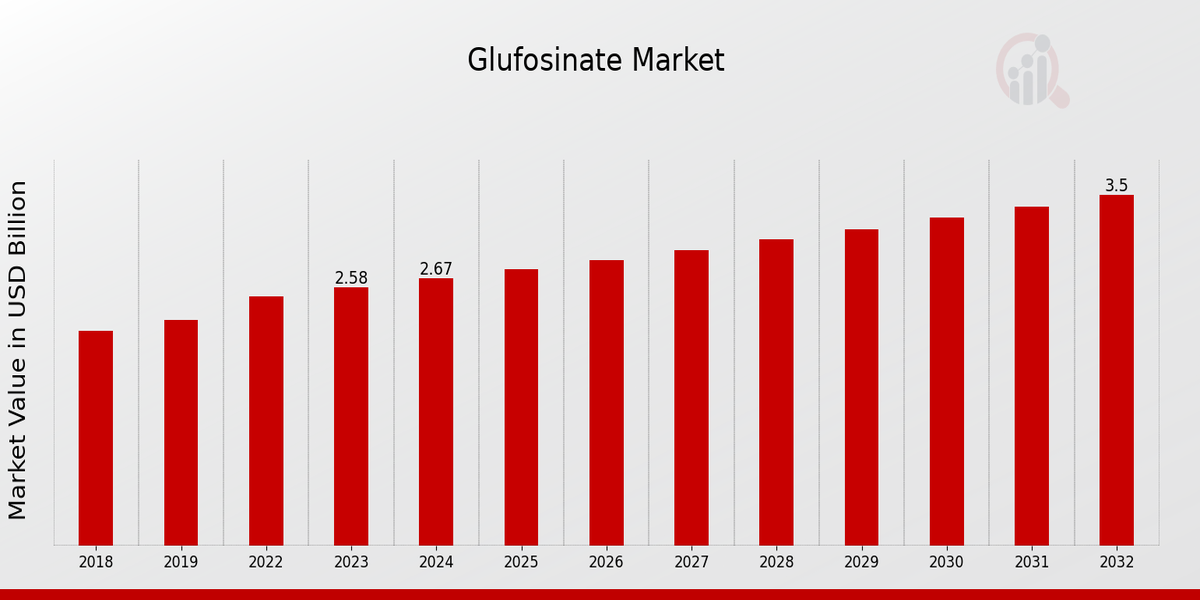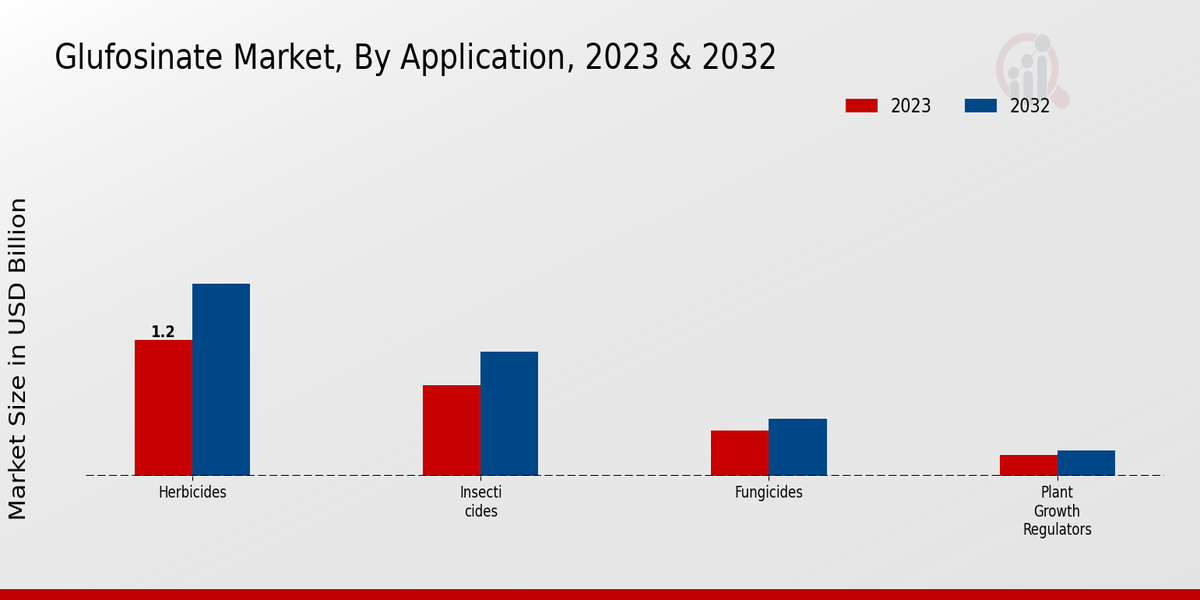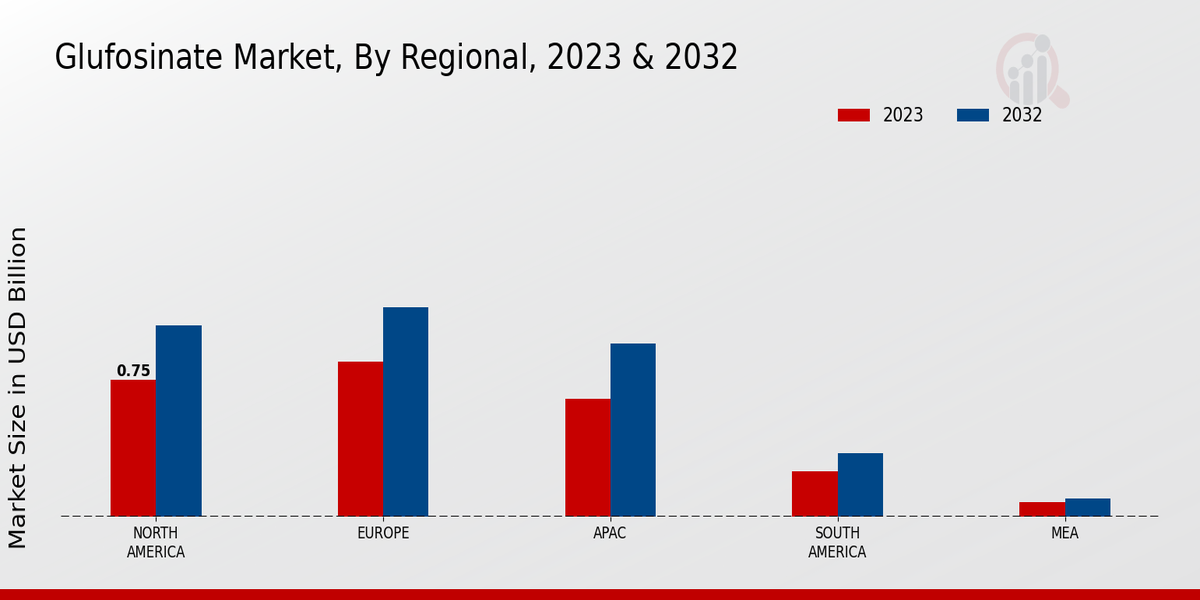Global Glufosinate Market Overview
Glufosinate Market Size was estimated at 2.49 (USD Billion) in 2022. The Glufosinate Industry is expected to grow from 2.58(USD Billion) in 2023 to 3.5 (USD Billion) by 2032. The Glufosinate Market CAGR (growth rate) is expected to be around 3.46% during the forecast period (2024 - 2032).

Source Primary Research, Secondary Research, MRFR Database and Analyst Review
Key Glufosinate Market Trends Highlighted
Growing demand for sustainable agriculture is driving the glufosinate market as farmers seek effective weed control solutions that minimize environmental impact. The increasing adoption of genetically modified crops resistant to glufosinate herbicides further fuels market growth. Additionally, awareness of food security and the need for higher yields in agricultural production are pushing the adoption of glufosinate-based products. These drivers point to a significant shift towards methods of farming that reduce chemical residues and promote eco-friendly practices. There are various opportunities to be captured in this evolving landscape.
As the trend towards organic and sustainable farming continues, there is potential for innovation in glufosinate formulations to meet the growing demand. New product development can focus on improved efficacy and reduced toxicity, appealing to a broader range of agricultural sectors. Moreover, emerging markets, particularly in developing regions, present a significant growth opportunity as farmers increasingly look for reliable herbicide options to enhance crop productivity. Recent trends show a rise in regulatory scrutiny regarding herbicide use, which is prompting manufacturers to invest in research and development. This includes exploring biotechnological approaches to improve glufosinate's effectiveness while ensuring compliance with environmental regulations.
The integration of digital agriculture tools, allowing for better crop management and precise application of herbicides, is also gaining traction. These trends indicate a transition toward advanced farming techniques that utilize glufosinate more efficiently, aligning with sustainability goals. Overall, the glufosinate market reflects a dynamic interplay of demand for sustainable solutions and innovation that addresses current agricultural challenges.
Glufosinate Market Drivers
Growing Demand for Sustainable Agriculture Practices
The Glufosinate Market Industry is witnessing a significant trend towards sustainable agriculture practices as farmers and agricultural companies increasingly prioritize environmentally friendly solutions. This shift is primarily driven by the rising awareness of the adverse effects of chemical fertilizers and pesticides on the environment, human health, and biodiversity. Glufosinate, a non-selective herbicide, is favored in this transition as it allows for effective weed control while minimizing environmental impact.
As farmers seek to adopt integrated pest management strategies and sustainable farming techniques, the demand for Glufosinate is anticipated to grow. The ability of Glufosinate to enhance crop yields, reduce soil degradation, and support sustainable crop production makes it a preferred choice among agronomists and farmers alike. Furthermore, government initiatives aimed at promoting organic farming and reducing chemical dependency further bolster the adoption of Glufosinate in various agricultural practices.
The growing trend towards precision agriculture also enhances the appeal of Glufosinate, as it facilitates the targeted application of herbicides, thereby improving efficiency and reducing waste. Hence, the alignment of Glufosinate with sustainable agricultural objectives positions it as a key driver in the Glufosinate Market Industry.
Increasing Crop Production to Meet Food Demand
The Glufosinate Market Industry is significantly influenced by the need to increase agricultural productivity to meet the growing food demand. As the world's population continues to expand, the pressure on agricultural systems intensifies, necessitating the adoption of effective herbicides like Glufosinate. This chemical enables farmers to control stubborn weeds that compete with crops for nutrients and water, ultimately leading to improved yields.
By enhancing crop productivity, Glufosinate serves as a vital component in addressing food security challenges. Agricultural stakeholders are increasingly recognizing the importance of using advanced herbicides to maximize production efficiency while maintaining the quality of crops. Therefore, the demand for Glufosinate is poised to rise as it plays a crucial role in ensuring food availability for the population.
Technological Advancements in Crop Protection
Advancements in agricultural technologies are reshaping the Glufosinate Market Industry, driving the development of more effective herbicides and pest management solutions. Innovations such as genetically modified crops that are tolerant to Glufosinate enhance its utility in modern farming practices. These technologies not only improve the performance of Glufosinate but also make it an indispensable tool for farmers looking to streamline their operations.
Over time, enhanced formulations and application techniques are expected to emerge, strengthening the market presence of Glufosinate and catering to the evolving needs of the agriculture sector.
Glufosinate Market Segment Insights
Glufosinate Market Application Insights
The Glufosinate Market is expected to experience promising growth, particularly within the Application segment, reflecting a steady rise in market valuation. In 2023, the Application segment is valued at 2.58 USD Billion, climbing to 3.5 USD Billion by 2032, showcasing a healthy market evolution over the coming years. The Application segment comprises various categories, which include Herbicides, Insecticides, Fungicides, and Plant Growth Regulators, each contributing uniquely to the overall market dynamics. Among these, Herbicides emerged as a significant player with a market value of 1.2 USD Billion in 2023, projected to reach 1.7 USD Billion by 2032, reflecting its vital role in agricultural practices. This predominance can be attributed to the increasing demand for effective weed control solutions as agricultural productivity continues to be a major focus internationally.
Insecticides also play a crucial role in the market, valued at 0.8 USD Billion in 2023 and expected to grow to 1.1 USD Billion by 2032. The significant growth in this category can be linked to rising pest infestations that threaten crop yields, thus necessitating effective insect control measures, ensuring not only crop safety but also food security for a growing population. Fungicides, while smaller in comparison, maintain their influence within the market, currently valued at 0.4 USD Billion and anticipated to reach 0.5 USD Billion. The importance of Fungicides lies in their ability to combat fungal diseases that could devastate crops if left unchecked, making them an essential component in integrated pest management strategies.
Plant Growth Regulators, valued at 0.18 USD Billion in 2023 and projected to increase to 0.22 USD Billion in 2032, serve a more specialized function by enhancing plant growth and yield quality. Although their market share is notably smaller, their role is significant in optimizing agricultural outputs and improving the efficiency of crop production. As the Glufosinate Market continues to evolve, trends indicate an increasing inclination towards sustainable and efficient farming practices, which is likely to drive the demand for all application types, especially Herbicides and Insecticides. The market faces challenges such as regulatory pressures and the growing preference for organic farming methods, creating both challenges and opportunities for innovation within the sector. Thus, the Glufosinate Market segmentation through the Application category exhibits a robust framework for understanding market dynamics, trends, and the demand for effective agricultural solutions.

Source Primary Research, Secondary Research, MRFR Database and Analyst Review
Glufosinate Market Crop Type Insights
The Glufosinate Market revenue in 2023 is valued at 2.58 USD Billion and is projected to grow steadily with a noteworthy CAGR of 3.46 from 2024 to 2032. The market segmentation by Crop Type reveals significant differences in demand and application among various categories. Cereals, for instance, form a crucial component, as they are essential for food security and are widely cultivated worldwide. Fruits and Vegetables, on the other hand, require effective pest control to meet consumer demand for quality produce, making glufosinate an important herbicide in this segment.
Pulses have also gained traction due to their role in sustainable agriculture, enhancing soil fertility. Finally, Oilseeds dominate the market due to their crucial application in the food and biofuels industries, underscoring glufosinate's importance in managing weeds that threaten yield. The overall dynamics of the Glufosinate Market data reflect how these segments interplay to meet agronomic needs and evolving agricultural practices, influenced by trends towards more sustainable farming solutions. Market growth is further driven by a growing awareness of sustainable agricultural practices, though challenges related to regulatory scrutiny and environmental concerns persist in shaping the industry.
Glufosinate Market Formulation Type Insights
The Formulation Type segment of the Glufosinate Market has shown steady growth, with the overall market valued at 2.58 billion USD in 2023 and projected to reach 3.5 billion USD by 2032. Within this segment, Liquid Concentrates, Granules, and Soluble Powders play crucial roles in the agricultural sector. Liquid Concentrates hold a significant share due to their ease of application and effectiveness in various environmental conditions. Granules are favored for their controlled release properties, appealing to farmers looking for long-lasting weed control solutions.
Soluble Powders are also on the rise, thanks to their versatility and efficient formulation that ensures better mixing and application. Overall market growth is driven by increasing demand for effective herbicides, advancements in formulation techniques, and rising crop production requirements. However, challenges like regulatory restrictions and potential health concerns are influencing market dynamics. The trends indicate a growing inclination towards more eco-friendly formulations, presenting opportunities for innovation within the Glufosinate Market.
These dynamics clearly reflect the diverse landscape of Glufosinate Market segmentation and the evolving needs of the agricultural industry.
Glufosinate Market Distribution Channel Insights
The Glufosinate Market has shown steady growth through its Distribution Channel segment, which includes Direct Sales, Distributors, and Online Retail. In 2023, the market was valued at 2.58 USD Billion, with expectations to reach 3.5 USD Billion by 2032. The increase in market revenue is primarily driven by rising demand for herbicides, especially in developing regions where agricultural practices are evolving. Direct Sales channels play a crucial role, offering personalized service and immediate product availability, while Distributors often provide broader reach and logistical support, enabling products to penetrate diverse markets more effectively.
Online Retail has emerged as a significant player, catering to consumers' preferences for convenience and access to a wide range of products, which enhances market visibility. The efficiency and accessibility provided by these channels not only boost the Glufosinate Market statistics but also present opportunities for future growth amidst emerging agricultural needs. As a result, understanding the dynamics of these channels is essential for leveraging market potential and addressing consumer demands in the Glufosinate Market industry.
Glufosinate Market Regional Insights
The Glufosinate Market revenue reflects a prominent growth trajectory across various regions, with North America’s valuation of 0.75 USD Billion in 2023, rising to 1.05 USD Billion by 2032. Europe led the market with a significant market value of 0.85 USD Billion in 2023 and expected to reach 1.15 USD Billion by 2032, showcasing its substantial contribution to the industry. The APAC region, valued at 0.65 USD Billion in 2023 and projected to grow to 0.95 USD Billion by 2032, also plays a vital role, driven by rising agricultural practices and demand for herbicides.
South America and MEA represent smaller markets, valued at 0.25 USD Billion and 0.08 USD Billion respectively in 2023, yet they present growth opportunities due to increasing agricultural activities in developing countries. The market growth in these regions is supported by the rising need for efficient herbicides and the promotion of sustainable agricultural practices. Each region presents unique challenges and opportunities, making the Glufosinate Market segmentation essential for understanding diverse market dynamics and ensuring strategic positioning within the industry.

Source Primary Research, Secondary Research, MRFR Database and Analyst Review
Glufosinate Market Key Players and Competitive Insights
The competitive landscape of the Glufosinate Market is shaped by various factors, including technological advancements, regulatory frameworks, and the evolving needs of the agricultural sector. Key players are increasingly focusing on product innovation and strategic partnerships to strengthen their market presence. Glufosinate, a non-selective herbicide, is widely used for weed control in various crops, making its market dynamics particularly intricate. Players in this domain are striving to enhance the effectiveness and safety profiles of their formulations while also addressing environmental concerns associated with herbicide use. Furthermore, the market is witnessing a trend towards sustainable agricultural practices, where companies are adapting their strategies to align with environmentally friendly and organic farming practices. This has resulted in heightened competition as manufacturers aim to balance efficacy with sustainability.
Corteva Agriscience holds a prominent position in the Glufosinate Market, leveraging its extensive research and development capabilities to innovate and deliver high-quality herbicides. The company is recognized for its commitment to agriculture and sustainability, which underscores its brand reputation. Corteva Agriscience has developed a range of glufosinate products that not only meet the regulatory requirements but also cater to the diverse needs of growers. The company benefits from a robust distribution network that enables it to efficiently reach various agricultural markets around the globe. Additionally, Corteva's focus on integrating digital technologies into its farming solutions showcases its forward-thinking approach, enhancing the overall effectiveness of its herbicide solutions in real-world applications. The continuous investment in R&D positions Corteva Agriscience as a strong contender in this competitive market, allowing it to maintain a distinctive edge over its competitors.
BASF is another key player within the Glufosinate Market, known for its comprehensive portfolio of agricultural solutions that include high-performance herbicides. The company’s dedication to innovation and product development is evident in its glufosinate offerings, which prioritize both effectiveness against weeds and user-friendly application methods. BASF's expertise and long-standing experience in chemical manufacturing contribute significantly to its market presence, establishing it as a trusted name among agricultural professionals. The company emphasizes sustainable agriculture, aligning its glufosinate products with farming practices that minimize environmental impact while maximizing yield. BASF’s strategic investments in sustainability research further enhance its competitive stance as the market increasingly shifts towards eco-friendly solutions. This focus enables BASF to appeal to a broader customer base while solidifying its position in the evolving landscape of the Glufosinate Market.
Key Companies in the Glufosinate Market Include
Glufosinate Market Industry Developments
Recent developments in the Glufosinate Market have been significantly shaped by various industry dynamics and corporate actions. Companies such as Corteva Agriscience, BASF, and FMC Corporation continue to innovate in developing glufosinate-based herbicides to meet the growing demand for effective weed management solutions in agriculture. Rising concerns regarding sustainable agriculture practices are influencing the market, pushing organizations like Bayer and Syngenta to improve their product formulations while ensuring environmental safety. Additionally, the strategic mergers and acquisitions in this sector have been noteworthy; particularly, companies like UPL Limited and ChemChina have expanded their portfolios through targeted acquisitions aimed at enhancing their competitive advantage and market reach. The increasing valuation of these companies is reflective of a robust demand for herbicides, prominently glufosinate, spurred by both traditional and organic farming practices. As agricultural efficiency and environmental sustainability become paramount, market players are adjusting to these shifts, thereby impacting their growth trajectories within the Glufosinate Market.
Glufosinate Market Segmentation Insights
-
Glufosinate Market Application Outlook
- Herbicides
- Insecticides
- Fungicides
- Plant Growth Regulators
-
Glufosinate Market Crop Type Outlook
- Cereals
- Fruits and Vegetables
- Pulses
- Oilseeds
-
Glufosinate Market Formulation Type Outlook
- Liquid Concentrates
- Granules
- Soluble Powders
-
Glufosinate Market Distribution Channel Outlook
- Direct Sales
- Distributors
- Online Retail
-
Glufosinate Market Regional Outlook
- North America
- Europe
- South America
- Asia Pacific
- Middle East and Africa
| Report Attribute/Metric |
Details |
| Market Size 2022 |
2.49(USD Billion) |
| Market Size 2023 |
2.58(USD Billion) |
| Market Size 2032 |
3.5(USD Billion) |
| Compound Annual Growth Rate (CAGR) |
3.46% (2024 - 2032) |
| Report Coverage |
Revenue Forecast, Competitive Landscape, Growth Factors, and Trends |
| Base Year |
2023 |
| Market Forecast Period |
2024 - 2032 |
| Historical Data |
2019 - 2023 |
| Market Forecast Units |
USD Billion |
| Key Companies Profiled |
Corteva Agriscience, BASF, FMC Corporation, Aldena, Jiangsu Jialong Chemical, Haoyang Chemical, Bayer, Sarex, Nufarm, Zhejiang Jinfanda Biochemical, Hanfeng Evergreen, Everris, Syngenta, UPL Limited, ChemChina |
| Segments Covered |
Application, Crop Type, Formulation Type, Distribution Channel, Regional |
| Key Market Opportunities |
Rising demand for herbicide-resistant crops, Increasing adoption of sustainable agriculture, Growth in organic farming practices, Expansion in developing markets, Advances in biotechnology enhancements |
| Key Market Dynamics |
Rising demand for herbicides, Increasing adoption of biotechnology, Regulatory pressures on pesticide use, Growing organic farming practices, Market competition and pricing pressure |
| Countries Covered |
North America, Europe, APAC, South America, MEA |
Frequently Asked Questions (FAQ) :
The Glufosinate Market is expected to be valued at 3.5 billion USD in 2032.
The Glufosinate Market is expected to grow at a CAGR of 3.46% from 2024 to 2032.
The market value of Glufosinate herbicides is anticipated to reach 1.7 billion USD by 2032.
Key players in the market include Corteva Agriscience, BASF, FMC Corporation, and Bayer, among others.
The market size for Glufosinate insecticides is expected to be 1.1 billion USD in 2032.
The Glufosinate Market in North America is valued at 0.75 billion USD in 2023.
The market values are expected to be 0.5 billion USD for fungicides and 0.22 billion USD for plant growth regulators by 2032.
In 2032, the market size for the Glufosinate Market in APAC is expected to reach 0.95 billion USD.
Challenges such as regulatory issues and competition from alternative products may impact market growth.

















